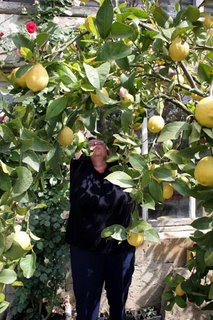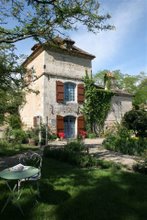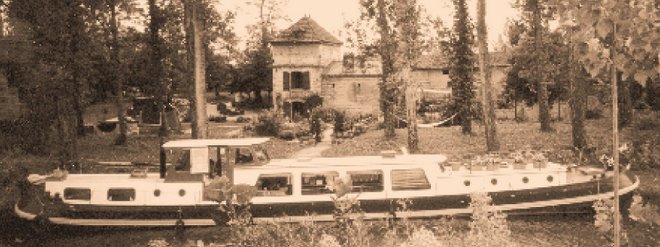May 31, 2006
Bonjour! from the Bleu Bateau Café
Not all French food is complicated. Here in the sweet countryside of Southwest France, I have found the little tricks and secrets that make cooking like a French grandmother easy--a busy French grandmere! The best and freshest produce jumps into my market basket every Saturday as DuPont and I jump into the 2CV (that little cartoon French car!) and head to Nerac along the Baise River. An impromptu menu begins with radishes with their greens for a simple peppery soup, a bundle of fresh garlic to rub over grilled country bread, a duck breast to grill, slice thinly, and drizzle with a red wine sauce made with a glass of wine, a shallot and some honey to sweeten the end. I drown a box of ruby strawberries with a vanilla pod in a bowl of wine and some sugar cubes and serve it in glasses for dessert. Simple, easy and so French!
Shopping in the small villages that line my canal, a Long Village of good food and wine, is a fat lesson in French cooking. The baker, butcher and wine maker will tell me how to prepare their favorite dishes; my neighborhood is like a living cookbook. Afterwards, sitting in the village café with a petit blanc (a little white wine) or a mure-rouge (blackberry and red wine) with DuPont at my feet, I write the little stories that my market friends have told me. My French neighbors love good food and they are proud to share their specialties in tips and tastes. Curious about what and how I cook, Xavier asks me if I know how to stuff a quail with grapes and cook it over a bed of vine clippings. Dominique tells me to place a bay leaf between each slice of the pork roast he is cutting for me, wrap it in bacon and roast it for 20 minutes a kilo- no more! Francoise slices pain d’epice, like gingerbread, and serves it with a dab of duck rillettes, it becomes a new favorite. Jean-Francoise, the self-crowned King of Ducks, hands me a slice of salt-and-pepper-cured magret or duck ham wrapped around a nugget of raw foie gras. Take that you supermarket wimps!
At the end of the umbrella-ed allée is a small stand of organic treasures- fresh garlic, sweet beets, tender courgettes and the first real cherry-like tomatoes. Now I have dessert! By the time I load the trunk of the raspberry red convertible I have enough recipes for a chapter in a new book- ‘Eating the Long Village!’ ; by the time I return to my Van Gogh blue barge, tonight’s dinner has solidified into a gentle and easy meal to cook for friends. Don’t forget- "Cook fast, drink light, have fun! "
Menu
Aperos sucre-salé
Duck rillettes served on gingerbread toast
Soupe aux fanes de radis
Radish leaf soup
Roti de porc en robe de ventrêche et laurier
Bay-scented Pork roast wrapped in bacon
Dessert en douce!
Savory dessert- sweet cherry tomatoes
served with real crème fraiche and sprinkled with olive salt from Majorca.
A creamy rich fresh tasting savory surprise to finish the meal with a sweet wine!
May 20, 2006
shop local: Spring turnips and radish greens with flirting on the side
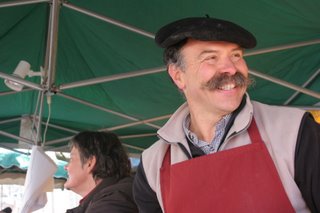
The Saturday morning market at Nerac is Flirting 101. Newbies Brits and other tourists make their way cautiously down the crowded narrow corridor of bright umbrellas—a gauntlet of fresh meat, artisan charcuterie and the best and freshest local produce. Their fear and timidity palpable as they try to decipher ‘safe’ paté from French disguised offal; compare kilos to pounds and euros to pounds or dollars. They shop with their eyes, but they haven’t learned the difference yet between the local producer vendor with a few cases of crisp apples from his own orchards labeled “coteaux de Ste. Colombe-en-Bruilhois” and the marketeer who brings in produce from the marché au gare or wholesale market from as far away as Israel and as close as over the non-existent border in Spain. They don't get the flirt because they are so afraid.
Seasoned French housewives and vieux garcons use baskets, canes and umbrellas to keep their place in competitive lines. (ask David Lebovitz about his encounters with les French furies!) They shop every week, they watch the prices by the centime, they buy half-loaves of bread, a smaller wedge of cheese, barely two hundred grams of perfect pork roast. They are not to be trifled with but to be watched and in watching learn their shopping strategies and techniques. They may not look the type but they flirt shamefully if a few more euros are at stake.
As an inside-outsider (having lived nearly 20 years here) I play a different game. I’ve learned the names and weaknesses of my favorite vendors and I trade on their friendship mercilessly. I bring a jar of my homemade apricot jam to Bernard who doles out a sample of perfectly-aged Manchego cheese and then announces a little too loudly to everyone in line that "he knows what I like". I buy a half of round of Brillant-Savarin that has a texture to rival the best butter I ever ate and a wedge of that Manchego that he brings back from central Spain when he visits his family. (That's another definition of local-where your family comes from.)
Hearts beat quickly as I approach the gastronomic bazaar of Kakou, a long extended wagon unfolded to display the variety of artisanally produced breads, sweets and charcuterie. Regardless of pretty Francoise’s eagle eye over her long-haired and smiling Kakou, he comes out from his knives and sweet hams to exchange the Gascon bizou- a kiss on each cheek and then another pair of sweet pecks. It’s double or nothing here in the Southwest.
While sipping a taste of cold saffron aperitif and nibbling a slice of saucisson aux noix and a piece of pain d’epices, I choose a loaf of pain levant, slightly sour and nutty at the same time, and two hand cut slices of ham. I leave lighter in spirit if not in kilos.
The market compresses its last few meters and the crowded line at the Chapolard brother’s “l’Art du Cochon” is my last stop. I watch anxiously as the last fresh sausage is sold. I modify my order as the boudin evaporates client by client, the ventrèche goes and the peppery dried tenderloins gets spoken for. My menu disappears into other people’s baskets. The line moves excruciately slow as each customer oversees the careful wrapping and weighing of kilos and kilos of carefully raised pork. Where as this is just a once a week ritual for many, it is a commited relationship for me. The flirting is more serious here. How many people are coming to dinner? When do you want to eat that dried sausage? Have you ever tried cooking the shoulder roast with bay leaves and shallots? The ultimate serious flirt is to seduce you with the best. This pork is so lovingly and carefully raised that the Brothers Chapolard might just as well come to my French Kitchen and cook it for me. Twice a week, four brothers and their wives trade rubber boots and butchers aprons for market clothes and smiles. They offer the best they can grow and sell it with pride.
Like a 13 year old with a crush on her teachers, I fall in love a little each week at my very local very good marché. Love make shopping local easy.
My Market list for Saturday may 20 2006:
A packet of fat radishes with very fresh greens
A bunch of young shallots sprouts
A Batavia lettuce
4 artichauts
3 kilos of apples
A wedge of manchego
Half a round of brilliant-savarin
A loaf of pain au levant
Two slices of ham
A kilo of cherries
2 bunches of spring turnips
A chunk of lightly smoked bacon
A terrine de porc
Two pigs feet
One saucisson
After the market Menu back on the Gascon ranch-
One Sausage slice and a glass of kir gascon
Spring turnip and radish leaf soup
Served with a slice of home-cured bacon
A green salad with simple vinaigrette
A chunk of bread
A slice of cheese
A hand full of cherries
A glass of good very local wine- cotes de brulhois
See you in Nerac next week.
May 11, 2006
'P' is for pelle
Digging in the thick clay Garonne River floodplain is hard work--fertile, sticky, dense, rocky and full of centuries old weed seeds. This is not the gardening they show on TV, this is not even the part I remember last year when PBS's Smart Gardening program filmed my potager. I think this is the part of gardening memories that evaporates like rain clouds in the last three drought dry summers. Why is there not a chintz print gardening tunic? Candy colored gloves? Elegant little wheelbarrow? I'll tell you why in two words-
cow shit
My new capri summer pants are now grass and other stained.
My nails are dirt-encrusted even though I was wearing serious gloves.
The rusty wheelbarrow is slopped with manure enriched compost from the Sabadini farm up the road.
so why am I smiling knee deep in merde?
I have seen the effects of this dark magic at my neighbors farm. Hay grows lightening-like under the spring sky; peach trees blossom clouds of future fruit; a solitary lemon tree produces a treasure trove of citrons to sharpen summer cooking. So whenever I can get Denis Sabadini to drive his tractor down the little one lane driveway that links 11 varied houses on this chemin de campagne, his front loaded bucket full of well-rotted straw and manure, I am the happiest neighbor in this Long Village.
For the last 5 days I have been digging, weeding, clearing, wheelbarrowing. I smell like a farmer. I am happy. As my good friend Franny G. says, it's time to call "a shovel a spade."
P' might stand for the sweet parts of the potager--
the petits pois just planted,
the parasol that shelters the table,
the pommes de terre we will dig for summer salads--
but I know it really stands for pelle- the spade with which we shovel all that shit.
Here's to my Long Village neighbors!
May 05, 2006
'P' is for Mole Poblano
1. The potager is in the shade of the oak, walnut and acacia trees.
2. The late sunset (around 9pm and counting just now) seems to intensify the perfume from the aforementioned acacia blossoms. It's like working in a perfume factory.

It took me three days of here and there, but the grass paths that define the tic-tac-toe design of the eight 5X5 meter square beds is mown; The tomato plant stakes have been removed to a fix-it pile; the first square is nearly weed free. This means I am now allowed to buy tomato plants tomorrow at the marche au gravier in Agen. Thus begins the salsa square.
Canned, sauced, souped or pureed, most of my meaty French tomatoes will go for salsa to alleviate my cravings for the other Southwest-kine food. The jalapeno and tomatillo seeds will crowd the already foot-high seedlings that I'll buy at the market tomorrow. Cilantro seeds will be spread among the seedlings and last year's onions are already multiplying. Sweet corn will fill one square itself. All I miss are fresh corn tortillas.
As the garden year begins at the French Kitchen in earnest, I look forward to salsa enough to last until next Cinco de Mayo. I am glad the French lost that one! Thanks to my franco-American potager, I can enjoy the best of the South-West in the Sud-Ouest. Ole!
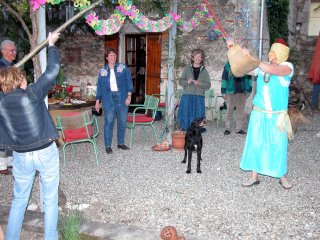
Garden Meteo- covered skies but warm and clearing; wardrobe-starting with a sweatshirt and ending up in a sleeveless T; Woad blue eyeshadow and coral earrings.
Time spent: negative because of nostalgic moments for last Cinco de Mayo party.
May 03, 2006
"P" is for Potager: French Roots Day #1
 I am late this year getting the potager in order. A month in the States teaching a Navarin d'Agneau- the French Kitchen way, attending the IACP conference in Seattle and working on 'THE TV Project' leaves me French-lagged rather than jet-lagged. It takes a week or so to adjust to two-hour lunches, bottles of wine for dinner, naps, slow market/shopping/gossiping, etc.
I am late this year getting the potager in order. A month in the States teaching a Navarin d'Agneau- the French Kitchen way, attending the IACP conference in Seattle and working on 'THE TV Project' leaves me French-lagged rather than jet-lagged. It takes a week or so to adjust to two-hour lunches, bottles of wine for dinner, naps, slow market/shopping/gossiping, etc.Last year at this time, the Potager was camera-ready as Dawn Ford and her PBS-'Smart Gardening' crew arrived to film a few French segments here at the French Kitchen. (More details on air dates at the Smart Gardening site!) I begin to rush to get things in order until I realize that for the first time, I am on schedule with what the old French folks say- wait until les saints de glace has passed to plant tomatoes.
So while William Alexander is enjoying the fruits of his $64 Dollar Tomato labor, I begin to think of my potager in how much time spent-- those hours of preparing and planting what will become my summer fast food. This is my Spring blog diversion into the world of the French Kitchen Potager: French Roots- a game of tic-tac-towpath.
Day 1: weather report- high wispy clouds, too much wind from the Mediteranean- the tramontana, high mid 5o's, wardrobe: brand new U.of O. fighting duck sweatshirt and a Miss Marple garden hat.
Idea- mow the grass paths and clean the beds of winter weeds. prepare one bed for planting all the seeds I brought from the States for the "American Square": Tomatilla, Okra, Jalapeno, Sweet Corn, etc...
Reality- get gas for the lawn mower , sharpen the blade since it can't cut through the tall damp grass, find the tools long scattered to barn, shed and boat, buy sunscreen, change shoes twice, find gloves, stop for water... play with Dupont. it'll be easier tomorrow.
Time Spent: nothing yet...

DuPont- part bird-dog, all mutt.

